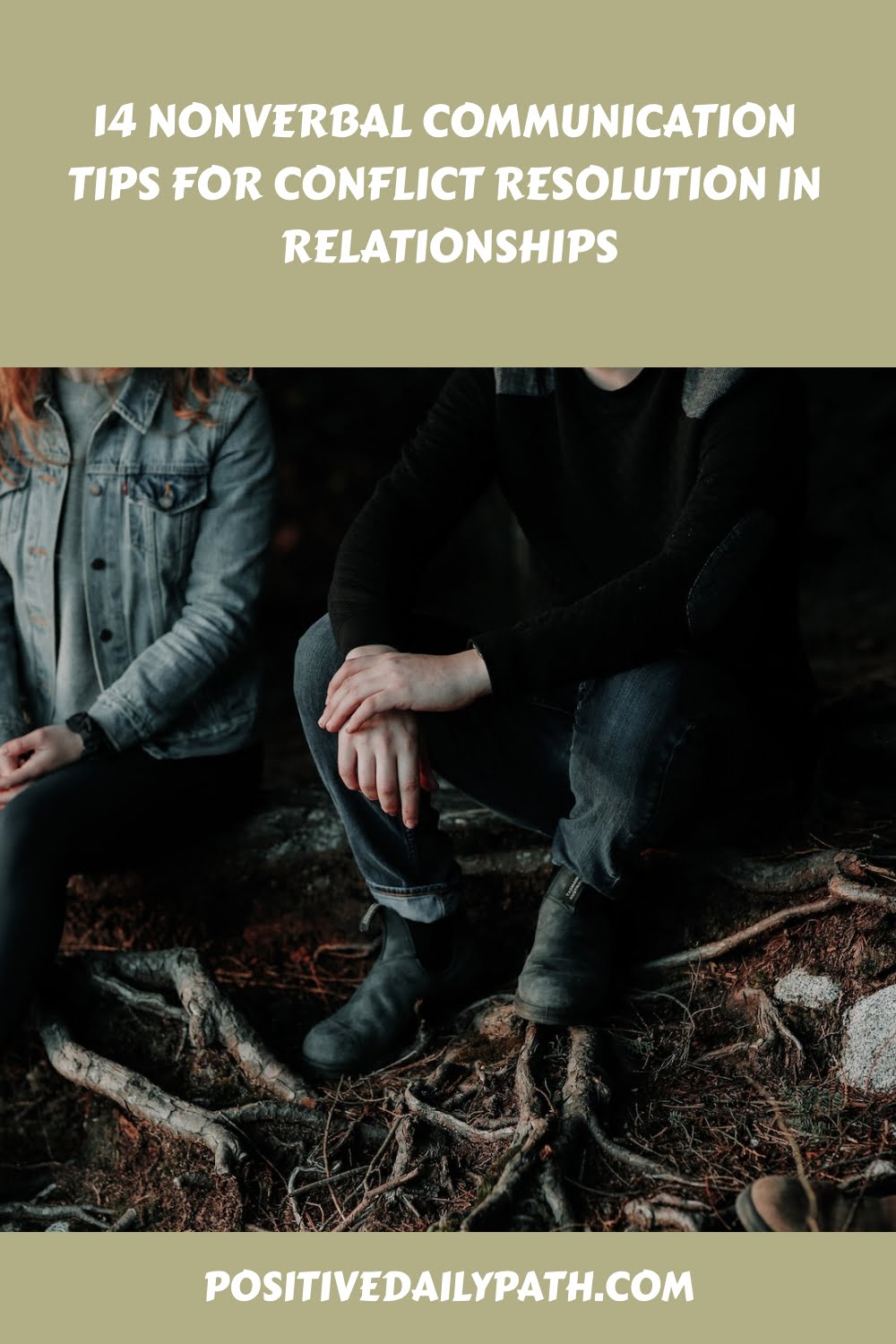Are conflicts in your relationships leaving you feeling frustrated and disconnected? Discover the power of nonverbal communication in resolving conflicts with these 14 practical tips. By maintaining eye contact, paying attention to body language, and using open gestures, you can create a safe and inviting space for effective communication. Practice active listening, regulate your tone of voice, and stay calm to foster understanding and connection. Seek nonverbal feedback from your partner and watch your conflicts transform into opportunities for growth and intimacy.
Key Takeaways
- Maintaining eye contact, using open gestures, and paying attention to body language are essential for effective nonverbal communication in conflict resolution.
- Creating a safe and comfortable environment is crucial to encourage nonverbal expressions of emotions and thoughts.
- Techniques such as giving space for nonverbal processing, being patient, and using touch appropriately can enhance nonverbal communication.
- Seeking nonverbal feedback, using nonverbal signals to indicate understanding, and understanding cultural differences in nonverbal communication are important in conflict resolution.
Maintain Eye Contact
To effectively communicate during conflict resolution in relationships, it is important for you to maintain consistent eye contact. Eye contact is a powerful nonverbal communication technique that can convey trust, empathy, and connection. When you maintain eye contact with your partner, you are showing them that you are fully present and engaged in the conversation. It lets them know that you are actively listening and valuing their perspective.
Maintaining eye contact also helps to establish a sense of intimacy and closeness. It creates a space for vulnerability and allows both partners to feel understood and validated. When you hold eye contact, you are signaling to your partner that you are willing to confront the conflict head-on and work towards a resolution together.
However, it's important to note that maintaining eye contact should be done in a respectful and non-threatening manner. Staring or glaring can come across as aggressive or confrontational, which can escalate the conflict further. Instead, focus on softening your gaze and maintaining a relaxed posture. This will help create a safe and open environment for effective communication and conflict resolution.
Pay Attention to Body Language
When resolving conflicts in relationships, it is crucial to pay attention to the body language of both yourself and your partner. Nonverbal cues can often reveal more than words alone, and understanding them can help you navigate through difficult conversations with empathy and understanding. Here are some tips to help you pay attention to body language during conflict resolution:
- Maintain eye contact: Looking into your partner's eyes shows that you value and respect their perspective. It also helps to establish a connection and foster open communication.
- Use open and inviting gestures: Avoid crossing your arms or appearing defensive. Instead, use open body language like uncrossed legs and relaxed shoulders to create a safe space for your partner to express themselves.
- Observe facial expressions: Facial cues can provide insight into your partner's emotions. Notice if they seem frustrated, sad, or anxious, and respond accordingly with empathy and compassion.
- Pay attention to posture: Is your partner leaning towards you or leaning away? Their posture can indicate their level of engagement or discomfort, allowing you to adjust your approach accordingly.
- Listen to tone and volume: Body language goes beyond physical movements. Pay attention to the tone and volume of your partner's voice, as it can reveal their emotional state and level of agitation.
Use Open and Inviting Gestures
When it comes to resolving conflicts in relationships, using open and inviting gestures can make a significant difference. By adopting body language that is open and receptive, you can create an atmosphere of trust and understanding. Simple gestures like maintaining eye contact, nodding in agreement, and keeping an open posture can convey your willingness to listen and find a resolution.
Importance of Body Language
Use open and inviting gestures to convey a positive and receptive attitude during conflict resolution in relationships. Your body language plays a crucial role in how your partner perceives your intentions and emotions. Here are some important reasons why using open and inviting gestures is essential:
- Creates a safe and welcoming environment for open communication.
- Demonstrates your willingness to listen and understand your partner's perspective.
- Helps to establish trust and build a stronger emotional connection.
- Reduces defensiveness and encourages cooperation.
- Conveys empathy and support, making your partner feel valued and heard.
Building Trust Through Gestures
To build trust in your relationship, employ open and inviting gestures that convey a positive and receptive attitude during conflict resolution. Building rapport through nonverbal communication skills is essential for fostering intimacy and resolving conflicts effectively. When engaging in a conversation with your partner, make sure to maintain an open posture by keeping your arms uncrossed and facing them directly. Use hand gestures that are welcoming and inclusive, such as open palms and gentle movements. Maintain eye contact to show your attentiveness and genuine interest in what they have to say. Avoid defensive gestures like crossing your arms or tapping your fingers, as they can create a barrier and signal disinterest. By using open and inviting gestures, you can establish a safe and trusting environment where both partners feel heard and understood.
Practice Active Listening
When it comes to resolving conflicts in relationships, practicing active listening is crucial. One important aspect of active listening is maintaining eye contact with your partner, as it shows your attentiveness and interest in what they are saying. Additionally, paying attention to their body language cues can help you understand their emotions and respond appropriately. Engaging with the speaker by nodding, asking clarifying questions, and paraphrasing their words can also demonstrate your commitment to understanding their perspective.
Eye Contact Importance
Maintain eye contact to actively listen and enhance nonverbal communication during conflict resolution in your relationships. Eye contact is a powerful tool that can help you establish a deeper connection with your partner and improve the effectiveness of your communication. Here are some benefits of maintaining eye contact during conflict resolution:
- Builds trust: Eye contact shows that you are fully present and engaged in the conversation, which can help build trust with your partner.
- Enhances understanding: By looking into your partner's eyes, you can better understand their emotions and intentions, allowing you to respond more empathetically.
- Promotes empathy: Eye contact helps you connect with your partner on a deeper level, fostering empathy and compassion.
- Minimizes misunderstandings: Clear eye contact can minimize misinterpretations and ensure that your message is conveyed accurately.
- Signals respect: Maintaining eye contact demonstrates respect and validates your partner's feelings and experiences.
Body Language Cues
Use body language cues to actively listen and improve nonverbal communication during conflict resolution in your relationships. Maintaining eye contact is one of the key aspects of interpreting body language. When you maintain eye contact with your partner during a conflict, you show them that you are fully present and engaged in the conversation. It conveys a sense of attentiveness and respect, making your partner feel heard and valued. Additionally, eye contact allows you to pick up on subtle nonverbal cues, such as facial expressions and body movements, which can provide insight into your partner's emotions and thoughts. By actively interpreting these cues, you can better understand their perspective and respond in a way that fosters understanding and resolution. Remember, nonverbal communication plays a significant role in conflict resolution, so utilize body language cues to enhance your listening skills and improve your relationships.
Engaging With Speaker
To effectively practice active listening and engage with the speaker during conflict resolution in relationships, focus on your partner's verbal and nonverbal cues. Engaging with your partner in a meaningful way can help foster understanding and strengthen your connection. Here are some active listening techniques to try:
- Maintain eye contact: Show your partner that you are fully present and attentive.
- Nod and provide verbal affirmations: Let your partner know that you are actively listening and understanding their perspective.
- Reflect and paraphrase: Repeat what your partner has said to ensure you have understood correctly.
- Ask open-ended questions: Encourage your partner to share more details and express their feelings.
- Avoid interrupting: Give your partner the space and time to fully express themselves.
Regulate Your Tone of Voice
Speak calmly and respectfully to effectively regulate your tone of voice during conflict resolution in relationships. When engaged in a heated argument, it's easy to let emotions get the best of you and respond with a raised voice or aggressive tone. However, taking a moment to regulate your tone can make a world of difference in resolving conflicts and fostering intimacy. One effective technique is mirroring, where you match the tone and volume of the other person's voice. This helps create a sense of understanding and connection, rather than escalating the situation. Additionally, be aware of defensive posturing, such as using a defensive or sarcastic tone, which can further inflame the conflict. Instead, strive for a tone that conveys empathy, understanding, and a willingness to listen. By speaking calmly and respectfully, you create a safe space for open communication and encourage your partner to do the same. Remember, regulating your tone of voice is crucial for conflict resolution and building a healthy, intimate relationship.
Show Empathy Through Facial Expressions
As you regulate your tone of voice during conflict resolution in relationships, it is crucial to show empathy through your facial expressions. Your facial expressions can speak volumes without you uttering a single word. Here are five ways you can use your facial expressions to demonstrate empathy and enhance nonverbal communication in conflict resolution:
- Maintain eye contact: Locking eyes with your partner shows that you are fully present and engaged in the conversation. It conveys that you are genuinely interested in understanding their perspective.
- Soften your facial muscles: Relax your facial muscles and avoid tense expressions. This helps create a safe and non-threatening environment, allowing your partner to feel more comfortable sharing their feelings.
- Use facial mirroring: Reflect your partner's emotions through subtle mirroring. This can help validate their feelings and show that you are attuned to their emotional state.
- Show a compassionate smile: A warm and compassionate smile can go a long way in diffusing tension and conveying understanding. It communicates that you genuinely care about your partner's well-being.
- Raise your eyebrows: Raising your eyebrows slightly can indicate surprise or curiosity. This gesture shows that you are open to hearing your partner's perspective and are willing to consider their point of view.
Use Touch Appropriately
When it comes to resolving conflicts in relationships, touch can be a powerful tool. However, it's important to use touch appropriately and respect boundaries. Understanding the nonverbal cues and signals of your partner can help you navigate touch in a way that is comfortable and supportive for both of you.
Boundaries and Touch
Your partner's boundaries and touch preferences play a crucial role in conflict resolution within your relationship. Understanding and respecting these boundaries is key to maintaining a healthy and intimate connection. Here are some tips on navigating touch in a way that promotes understanding and comfort:
- Communicate openly: Discuss touch boundaries with your partner and ensure you are both on the same page.
- Pay attention to body language: Observe your partner's nonverbal cues to gauge their comfort level with touch.
- Start with small gestures: Begin with light, non-invasive touches to test the waters and gauge their response.
- Respect personal space: Give your partner the freedom to establish their personal boundaries and respect their need for personal space.
- Take it slow: Gradually increase touch with consent, allowing your partner to feel safe and comfortable every step of the way.
Nonverbal Cues and Touch
Use nonverbal cues and touch appropriately to effectively communicate and resolve conflicts in your relationship. Nonverbal cues play a crucial role in creating intimacy and emotional connection with your partner. When engaging in conflict resolution, remember that touch can be a powerful tool for comfort and reassurance. A gentle touch on the arm or a warm embrace can convey empathy and support, letting your partner know that you are there for them. However, it is essential to be mindful of your partner's boundaries and comfort levels. Always ask for consent and respect their wishes. Touching with respect and sensitivity can deepen your emotional connection and reinforce the bond between you and your partner.
Give Space for Nonverbal Processing
Allowing for nonverbal processing can greatly enhance conflict resolution in your relationships. When emotions are running high and words seem to fail, nonverbal cues can provide valuable insights and understanding. Here are some ways to give space for nonverbal processing in your communication:
- Create a safe and comfortable environment: Ensure that both you and your partner feel secure and at ease during discussions. This will encourage nonverbal expressions of emotions and thoughts.
- Practice active listening: Pay attention not only to what is being said, but also to the nonverbal cues your partner is displaying. This includes body language, facial expressions, and gestures.
- Allow for silence: Sometimes, silence can be powerful. Give your partner the time and space to process their thoughts and emotions silently.
- Use gentle touch: Physical touch, such as holding hands or a reassuring pat on the back, can convey support and understanding without the need for words.
- Be patient and understanding: Nonverbal processing takes time. Avoid rushing your partner or pressuring them to speak before they are ready.
Use Mirroring Techniques
To enhance conflict resolution in your relationship, incorporating mirroring techniques can be beneficial. Mirroring is a powerful tool that allows you to connect with your partner on a deeper level and promote understanding. By mirroring their nonverbal cues, such as body language and facial expressions, you show empathy and validate their feelings. This simple act of mirroring can have profound benefits in resolving conflicts.
When you mirror your partner's nonverbal cues, you demonstrate your willingness to listen and understand their perspective. By reflecting their body language, you create a sense of trust and openness, making it easier for them to express themselves honestly. Mirroring also helps to establish rapport and build a stronger emotional connection, which is essential for resolving conflicts in a healthy and respectful manner.
To use mirroring techniques effectively, start by paying attention to your partner's nonverbal cues. Observe their body language, facial expressions, and tone of voice. Then, subtly mimic these cues to show that you are actively engaged and empathetic. Remember to use mirroring techniques genuinely and avoid imitation or mockery, as this can lead to further conflict.
Incorporating mirroring techniques into your conflict resolution strategy can create a safe and supportive environment for open communication. By mirroring your partner's nonverbal cues, you can foster understanding, validate their feelings, and work towards resolving conflicts together. Give it a try and experience the transformative power of mirroring in your relationship.
Manage Your Breathing
Take slow, deep breaths to help manage your breathing during conflicts. When tensions rise and emotions run high, focusing on your breath can be a powerful tool for calming your mind and body. Here are some breathing techniques and relaxation exercises you can try during times of conflict:
- Box Breathing: Inhale for a count of four, hold your breath for four, exhale for four, and hold for four. Repeat this cycle several times to bring a sense of calm.
- Deep Belly Breathing: Place one hand on your chest and the other on your belly. Take a deep breath in through your nose, filling your belly with air. Exhale slowly through your mouth, feeling your belly deflate. Repeat this process to release tension and promote relaxation.
- 4-7-8 Breathing: Inhale quietly through your nose to a mental count of four. Hold your breath for a count of seven. Exhale forcefully through your mouth to a count of eight. This technique can help regulate your breathing and reduce stress.
- Progressive Muscle Relaxation: Start by tensing and then releasing each muscle group, starting from your toes and working your way up to your head. Combine this exercise with deep breathing to promote a deep state of relaxation.
- Mindful Breathing: Focus your attention on your breath, noticing the sensation of each inhale and exhale. If your mind wanders, gently bring your attention back to your breath. This practice can help you stay present and centered during conflicts.
Stay Calm and Relaxed
To effectively navigate conflicts in your relationship, it is important to frequently practice staying calm and relaxed. Maintaining composure during difficult conversations can help create a safe and open environment for both you and your partner. When tensions rise, it's easy to let emotions take over and react impulsively. However, by staying calm, you can approach the situation with a clear mind and make better decisions.
There are several relaxation techniques that can help you stay calm and relaxed during conflicts. One effective method is deep breathing. Take slow, deep breaths in through your nose, hold for a few seconds, and then exhale slowly through your mouth. This simple technique can help calm your nervous system and reduce stress levels.
Another technique is progressive muscle relaxation. Start by tensing and then releasing each muscle group in your body, starting from your toes and working your way up to your head. This exercise can help you release tension and promote physical relaxation.
Additionally, taking breaks during heated discussions can be beneficial. By temporarily stepping away from the situation, you can give yourself time to calm down and gather your thoughts. Use this time to engage in activities that help you relax, such as going for a walk or listening to soothing music.
Avoid Defensive Posturing
- Prioritize open body language to avoid defensive posturing during conflicts in your relationship. When conflicts arise, it's natural to feel defensive and want to protect yourself. However, defensive posturing can escalate the situation and hinder effective conflict resolution. Instead, try these strategies to promote understanding and connection:
- Maintain eye contact: Look into your partner's eyes to show that you are actively listening and engaged in the conversation.
- Relax your body: Unclench your fists, uncross your arms, and take deep breaths to release tension and project a more open demeanor.
- Practice active listening: Nodding, using verbal cues like “uh-huh” or “I see,” and paraphrasing what your partner says demonstrate that you are actively trying to understand their perspective.
- Use a calm tone of voice: Speaking softly and evenly can help diffuse defensiveness and create a more peaceful atmosphere.
- Validate their feelings: Show empathy and understanding by acknowledging your partner's emotions, even if you don't agree with their viewpoint.
Use Nonverbal Signals to Indicate Understanding
To further promote understanding and connection during conflicts in your relationship, use nonverbal signals to indicate understanding. Building rapport and fostering a deep sense of empathy is crucial in resolving conflicts and strengthening your bond with your partner. Nonverbal communication techniques can play a significant role in achieving this goal.
One effective way to indicate understanding nonverbally is through active listening. Maintain eye contact with your partner and nod your head occasionally to show that you are fully engaged in the conversation. Open body language, such as facing your partner directly and keeping your arms uncrossed, will communicate receptiveness and a willingness to listen.
Another powerful nonverbal signal of understanding is mirroring. Mirroring involves subtly imitating your partner's body language, gestures, or even their tone of voice. This technique helps create a sense of connection and shows that you are attuned to their emotions and experiences.
Additionally, using touch can be a powerful way to convey understanding and support. A gentle touch on the arm or a comforting hug can communicate empathy and reassurance, letting your partner know that you are there for them.
Seek Nonverbal Feedback From Your Partner
When it comes to resolving conflicts in your relationship, seeking nonverbal feedback from your partner can play a crucial role. Nonverbal cues, such as body language and facial expressions, can provide valuable insights into your partner's thoughts and emotions, even when they might not be expressing them verbally. By paying attention to these cues, you can enhance your understanding of their perspective and address the conflict more effectively. So, remember to be observant and attuned to your partner's nonverbal signals during difficult conversations.
Importance of Body Language
Seeking nonverbal feedback from your partner is crucial for understanding their emotions and resolving conflicts effectively in your relationship. Body language plays a significant role in communication, often conveying more than words alone. Here are some reasons why paying attention to your partner's nonverbal cues is important:
- It provides insight into their true feelings and emotions.
- It helps you gauge their level of engagement and interest in the conversation.
- It allows you to identify any signs of discomfort or unease.
- It enhances empathy and understanding by reading their facial expressions and gestures.
- It promotes effective communication by encouraging active listening and responsiveness.
Enhancing Nonverbal Communication
Pay attention to your partner's nonverbal cues to enhance communication and seek feedback from them. Nonverbal communication plays a crucial role in understanding your partner's feelings and emotions. By observing their body language, facial expressions, and tone of voice, you can gain a deeper insight into their thoughts and intentions. However, it is important to remember that nonverbal cues can be easily misinterpreted, especially when there are cultural differences involved. To improve your interpretation skills, take the time to learn about your partner's cultural background and the nonverbal cues commonly used in their culture. Additionally, don't hesitate to ask your partner for clarification or feedback. Creating an open and safe space for communication will help strengthen your relationship and resolve conflicts more effectively.




